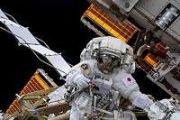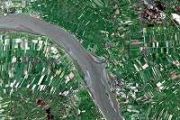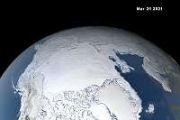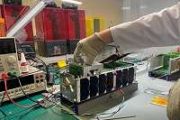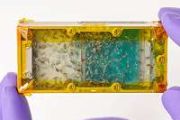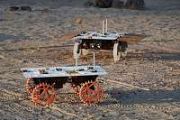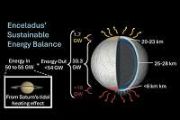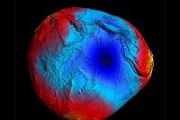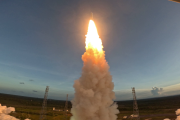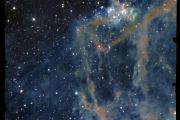
Copernical Team
Ax-1: why the private mission to the International Space Station is a gamechanger
 It's not long since billionaires were competing to get to the "edge of space". Now, the first set of private citizens are getting ready to take a SpaceX shuttle up to the International Space Station (ISS). Unlike the short "joyrides" of Richard Branson and Jeff Bezos, this mission will be reaching the roughly 400km altitude needed to dock with the ISS.
The mission by the US commercial aero
It's not long since billionaires were competing to get to the "edge of space". Now, the first set of private citizens are getting ready to take a SpaceX shuttle up to the International Space Station (ISS). Unlike the short "joyrides" of Richard Branson and Jeff Bezos, this mission will be reaching the roughly 400km altitude needed to dock with the ISS.
The mission by the US commercial aero Astranis Space Technologies signs with SpaceX for dedicated launch in 2023
 Astranis Space Technologies Corp. has signed a contract with SpaceX for a dedicated Falcon 9 launch to put four Astranis MicroGEO communications satellites into service in 2023.
The Astranis payload is well below the maximum payload capacity for a Falcon 9 vehicle, translating into a performance bonus that Astranis is using to tailor the insertion orbit to the mission and propel its compac
Astranis Space Technologies Corp. has signed a contract with SpaceX for a dedicated Falcon 9 launch to put four Astranis MicroGEO communications satellites into service in 2023.
The Astranis payload is well below the maximum payload capacity for a Falcon 9 vehicle, translating into a performance bonus that Astranis is using to tailor the insertion orbit to the mission and propel its compac Commercial research expands aboard the International Space Station
 The International Space Station has spent more than two decades in low-Earth orbit serving as Earth's orbiting laboratory. Groundbreaking research aboard the station in its unique microgravity environment has led to benefits back on the ground and paved the way for future deep space missions.
As NASA sets its sights once again on the Moon and eventually on Mars, low-Earth orbit is playing
The International Space Station has spent more than two decades in low-Earth orbit serving as Earth's orbiting laboratory. Groundbreaking research aboard the station in its unique microgravity environment has led to benefits back on the ground and paved the way for future deep space missions.
As NASA sets its sights once again on the Moon and eventually on Mars, low-Earth orbit is playing Elon Musk's Starlink loses frequencies in France
 Starlink, the satellite internet service of tech billionaire Elon Musk, has lost its frequencies in France after a legal battle waged by environmental groups.
In a ruling published Tuesday, the State Council, France's supreme court for administrative justice, quashed a February 2021 decision by the Arcep telecoms regulators granting Starlink two bands of frequencies to link the satellites wi
Starlink, the satellite internet service of tech billionaire Elon Musk, has lost its frequencies in France after a legal battle waged by environmental groups.
In a ruling published Tuesday, the State Council, France's supreme court for administrative justice, quashed a February 2021 decision by the Arcep telecoms regulators granting Starlink two bands of frequencies to link the satellites wi Axiom set to launch, next NASA moon rocket to wait a little longer for testing
 NASA has decided to pause testing on its next moon rocket, the Space Launch System, and instead proceed with the launch of SpaceX's first private astronaut mission, Axiom-1.
"We'll fall in behind [Axiom]," Jim Free, NASA's associate administrator for exploration systems development, said Tuesday at an Artemis briefing at the 37th annual Space Symposium conference in Boulder, Co.
NASA has decided to pause testing on its next moon rocket, the Space Launch System, and instead proceed with the launch of SpaceX's first private astronaut mission, Axiom-1.
"We'll fall in behind [Axiom]," Jim Free, NASA's associate administrator for exploration systems development, said Tuesday at an Artemis briefing at the 37th annual Space Symposium conference in Boulder, Co. Amazon strikes deals with 3 rocket firms for Kuiper satellite launches
 Amazon has struck deals with three rocket companies to launch Internet satellites, the company announced Tuesday, calling it "the largest commercial procurement of launch vehicles in history."
The tech giant has up to 83 launches planned over five years for its Project Kuiper Internet satellites. Its aim is to make high-speed, low-latency broadband service accessible across the globe. /
Amazon has struck deals with three rocket companies to launch Internet satellites, the company announced Tuesday, calling it "the largest commercial procurement of launch vehicles in history."
The tech giant has up to 83 launches planned over five years for its Project Kuiper Internet satellites. Its aim is to make high-speed, low-latency broadband service accessible across the globe. / DARPA, AFRL, Lockheed Martin And Aerojet Rocketdyne team up for Hypersonics test
 The Defense Advanced Research Projects Agency (DARPA), Air Force Research Lab (AFRL), Lockheed Martin (NYSE: LMT) and Aerojet Rocketdyne (NYSE: AJRD) team successfully flight tested the Hypersonic Air-breathing Weapon Concept (HAWC). This historic flight reached speeds in excess of Mach 5, altitudes greater than 65,000 feet and furthers the understanding of operations in the high-speed flight re
The Defense Advanced Research Projects Agency (DARPA), Air Force Research Lab (AFRL), Lockheed Martin (NYSE: LMT) and Aerojet Rocketdyne (NYSE: AJRD) team successfully flight tested the Hypersonic Air-breathing Weapon Concept (HAWC). This historic flight reached speeds in excess of Mach 5, altitudes greater than 65,000 feet and furthers the understanding of operations in the high-speed flight re Station waits for private astronauts during science and spacewalk preps
 The seven-member Expedition 67 crew will wait an extra day to greet the first private astronauts who are due to launch this weekend to the International Space Station. In the meantime, the orbital residents focused on human research and physics today while gearing up for a pair of spacewalks later this month.
The first private astronaut mission, Axiom Space-1 (Ax-1), is now scheduled to la
The seven-member Expedition 67 crew will wait an extra day to greet the first private astronauts who are due to launch this weekend to the International Space Station. In the meantime, the orbital residents focused on human research and physics today while gearing up for a pair of spacewalks later this month.
The first private astronaut mission, Axiom Space-1 (Ax-1), is now scheduled to la Amazon signs with Arianespace for 18 Ariane 6 launches to deploy Project Kuiper constellation
 Arianespace and Amazon (NASDAQ: AMZN) announced an unprecedented launch service contract during the International Space Symposium in Colorado Springs, USA, on April 5. Under the terms of the contract, Arianespace will perform 18 Ariane 6 launches for Amazon's Project Kuiper over a period of three years from Europe's Spaceport in French Guiana. Among the 18 launches planned for the deployment of
Arianespace and Amazon (NASDAQ: AMZN) announced an unprecedented launch service contract during the International Space Symposium in Colorado Springs, USA, on April 5. Under the terms of the contract, Arianespace will perform 18 Ariane 6 launches for Amazon's Project Kuiper over a period of three years from Europe's Spaceport in French Guiana. Among the 18 launches planned for the deployment of From sample to results: in-space data analysis enables quicker data return
 Space-based computing has achieved a significant milestone by enabling investigators conducting an experiment onboard the International Space Station (ISS) to go from sample analysis to results while the experiment was on station. The ability to process data onboard the ISS drastically reduces the time required for investigators to get data and enables potential iteration of the research while t
Space-based computing has achieved a significant milestone by enabling investigators conducting an experiment onboard the International Space Station (ISS) to go from sample analysis to results while the experiment was on station. The ability to process data onboard the ISS drastically reduces the time required for investigators to get data and enables potential iteration of the research while t 





